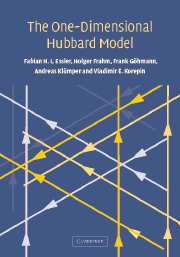Book contents
- Frontmatter
- Contents
- Preface
- 1 Introduction
- 2 The Hubbard Hamiltonian and its symmetries
- 3 The Bethe ansatz solution
- 4 String hypothesis
- 5 Thermodynamics in the Yang-Yang approach
- 6 Ground state properties in the thermodynamic limit
- 7 Excited states at zero temperature
- 8 Finite size corrections at zero temperature
- 9 Asymptotics of correlation functions
- 10 Scaling and continuum limits at half-filling
- 11 Universal correlations at low density
- 12 The algebraic approach to the Hubbard model
- 13 The path integral approach to thermodynamics
- 14 The Yangian symmetry of the Hubbard model
- 15 S-matrix and Yangian symmetry in the infinite interval limit
- 16 Hubbard model in the attractive case
- 17 Mathematical appendices
- References
- Index
10 - Scaling and continuum limits at half-filling
Published online by Cambridge University Press: 19 August 2009
- Frontmatter
- Contents
- Preface
- 1 Introduction
- 2 The Hubbard Hamiltonian and its symmetries
- 3 The Bethe ansatz solution
- 4 String hypothesis
- 5 Thermodynamics in the Yang-Yang approach
- 6 Ground state properties in the thermodynamic limit
- 7 Excited states at zero temperature
- 8 Finite size corrections at zero temperature
- 9 Asymptotics of correlation functions
- 10 Scaling and continuum limits at half-filling
- 11 Universal correlations at low density
- 12 The algebraic approach to the Hubbard model
- 13 The path integral approach to thermodynamics
- 14 The Yangian symmetry of the Hubbard model
- 15 S-matrix and Yangian symmetry in the infinite interval limit
- 16 Hubbard model in the attractive case
- 17 Mathematical appendices
- References
- Index
Summary
At half-filling the repulsive Hubbard model is in a Mott insulating phase. The charge degrees of freedom are gapped, whereas the spin degrees of freedom remain gapless. At low energies the spin sector is actually scale invariant (apart from logarithmic corrections) and Conformal Field Theory (CFT) methods may be applied to determine the low-energy behaviour of correlation functions involving only the spin sector. On the other hand, the charge sector is not scale invariant and CFT does not provide any information for correlators involving the charge degrees of freedom. In this chapter we will show that there exists a particular continuum limit of the half filled Hubbard model, in which it is possible to calculate dynamical correlation functions by means of methods of integrable quantum field theory. We first construct a Lorentz invariant scaling limit starting from the results for the excitation spectrum and the S-matrix discussed in Chapter 7. This scaling limit is identified as the SU(2) Thirring model, which is an integrable relativistic quantum field theory. Next we discuss a continuum limit, which is obtained directly from the Hubbard Hamiltonian and describes the vicinity of the scaling limit.
Construction of the scaling limit
The simplest way of constructing the scaling limit is to start with the results for the dispersions of the elementary excitations and the S-matrix derived in Chapter 7 and then look for a particular limit in which Lorentz invariance is recovered.
- Type
- Chapter
- Information
- The One-Dimensional Hubbard Model , pp. 333 - 375Publisher: Cambridge University PressPrint publication year: 2005



